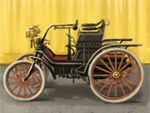Last month, I spoke at the Game Developers Conference in San Francisco, California. (It's primarily…
Game Submissions: Top 10 Things I Look For (Part 3)
I conclude this list of questions, looking at the final 3 questions I ask myself when I consider a game submission from a game designer for publication.
—
I spend a good amount of my time as a publisher looking at game submissions. I have identified the top 10 questions I ask myself when I consider whether or not I want to license them for publication. I covered the first 7 questions in my two previous posts:
- Does it fit our brand?
- What is the mechanical hook?
- Is it fun (to me, as it is)?
- How much will people pay for it?
- What will it cost me to manufacture?
- Do I get excited by the thought of spending time working on it?
- How close are the game mechanisms to being complete?
In this post, I look at the final 3 questions:
—
8. Is there a chance that tens of thousands of people would want to buy it?
 The board game business seems to me to be a hit-driven business. So many games come out each year. Many of them have a single print run and then fade into the past to be forgotten. If I spend so much time, energy, and money to prepare a game for publication, I really hope it breaks this cycle to become a hit that continues to sell well beyond that first print run. Could the product as a whole — the theme, the mechanics, the artwork, and everything else — appeal to enough people that it could be a hit? I want to publish games that have seem like they’ll have a chance to do that.
The board game business seems to me to be a hit-driven business. So many games come out each year. Many of them have a single print run and then fade into the past to be forgotten. If I spend so much time, energy, and money to prepare a game for publication, I really hope it breaks this cycle to become a hit that continues to sell well beyond that first print run. Could the product as a whole — the theme, the mechanics, the artwork, and everything else — appeal to enough people that it could be a hit? I want to publish games that have seem like they’ll have a chance to do that.
It’s worth noting that a game could be successful for me or other publishers even if it doesn’t actually become a hit. For bigger publishers, I can imagine that a single small print run might be considered a failure. But Kickstarter and other changes to the industry have made it possible for tiny publishers like me to make games on the side and have other goals than “make enough money to pay living expenses”. Making a game and selling out of a single small print run could still be worth doing and could still be considered a success.
(In fact, I think this is probably the question I would be most likely to ignore at some point. I could find a game with a small niche audience that I love so much, and I could see myself trying to find a way to make it work. It would definitely be an exception, and I’d be very careful to keep the fixed costs and the time spent in check — but I can easily imagine myself doing something like that in the future.)
—
9. Is it really fun (with a little development work, to multiple people)?
 Through my first few plays (by myself and with my family and my closest friends), I typically see some small things that I want to change. These usually nudge the game in one direction or another, encouraging players a little more to do what I’ve found to be fun in the game. I make some of these changes and then play the game with a few groups in the game’s target audience. I want to feel comfortable that people who I expect to buy the game find the core of the game really fun.
Through my first few plays (by myself and with my family and my closest friends), I typically see some small things that I want to change. These usually nudge the game in one direction or another, encouraging players a little more to do what I’ve found to be fun in the game. I make some of these changes and then play the game with a few groups in the game’s target audience. I want to feel comfortable that people who I expect to buy the game find the core of the game really fun.
While I was considering Lanterns, I added the descending point values for the different sets; that change encouraged players to make sets quickly and avoid hoarding cards. For World’s Fair 1893, I made a certain type of card worth 1 point each (instead of 0) to encourage players to keep the game moving.
I still expect a lot more playtesting and development to make the game the best it can be. (Take that card type in World’s Fair 1893 I mentioned: Alex and I later decided to get rid of it altogether.) Many people have asked me a variety of questions about what kind of changes get made in the development process, and I’m planning some posts about that.
—
10. Will I be proud of this game?
 The answer to this question is highly personal and subjective, of course, but it’s also very important to me. I always have this question in the back of my mind while I’m considering a game, and there have been a few submissions I have seen in person or received in email that I passed on right away because of this. But before I license the game, I look long and hard at this question. Will I be proud to show the finished product to my family and friends? Do I want my kids telling their friends at school about it? Will the world be a slightly better place because it has this game in it? This feeling has so far always grown during the development process, but I need to have a sense at the beginning that I will be proud of the game.
The answer to this question is highly personal and subjective, of course, but it’s also very important to me. I always have this question in the back of my mind while I’m considering a game, and there have been a few submissions I have seen in person or received in email that I passed on right away because of this. But before I license the game, I look long and hard at this question. Will I be proud to show the finished product to my family and friends? Do I want my kids telling their friends at school about it? Will the world be a slightly better place because it has this game in it? This feeling has so far always grown during the development process, but I need to have a sense at the beginning that I will be proud of the game.
—
Those are the 10 questions I ask myself when I consider game submissions for publication. Did any surprise you? What other questions should be asking?
—
* Illustrations by Beth Sobel from our upcoming game World’s Fair 1893: Daimler Quadricycle, Ferris Wheel, and The Republic.
This Post Has 4 Comments
Comments are closed.

[…] ← Previous Next → […]
I love how true to yourself you are =)
I suppose I don’t know how else to be. 🙂 Thank you for all the support!
Randy, Randy, Randy… you probably saved me weeks of agony and steepened my road to success with this article. 6 of the 10 points, I currently thought about as I’m wrestling through the creation of [yet] a game that i can produce. Each time I either reach a wall, violate one of those 6 I knew about, or other. I love how authentic you are to yourself in this, and it shows in how you write your article. Thanks for taking the time to share.